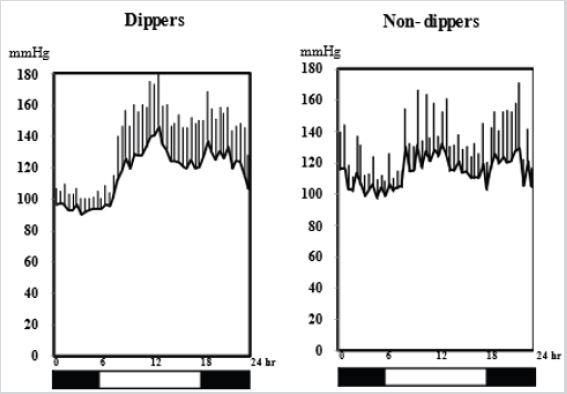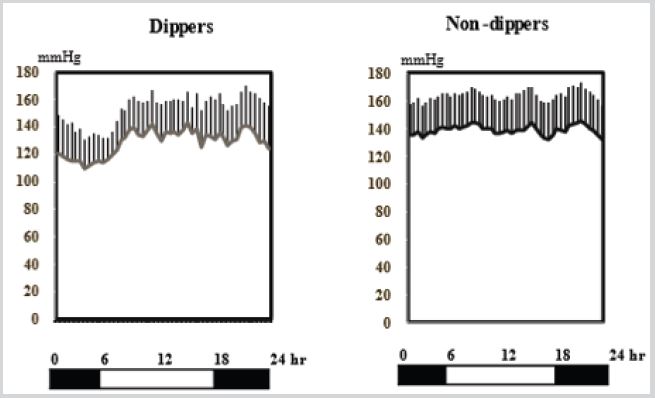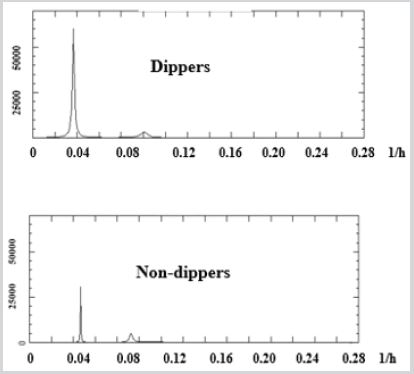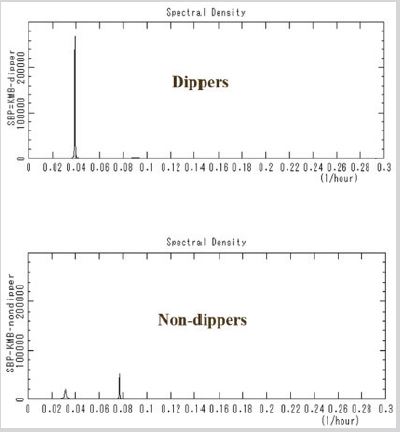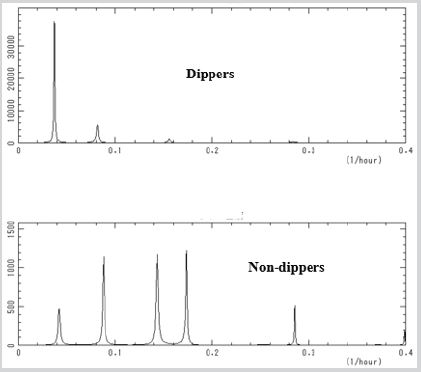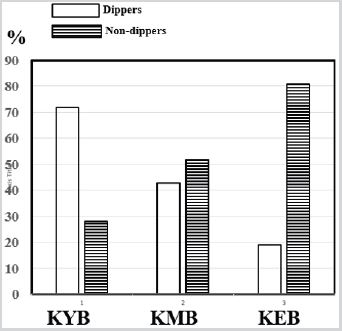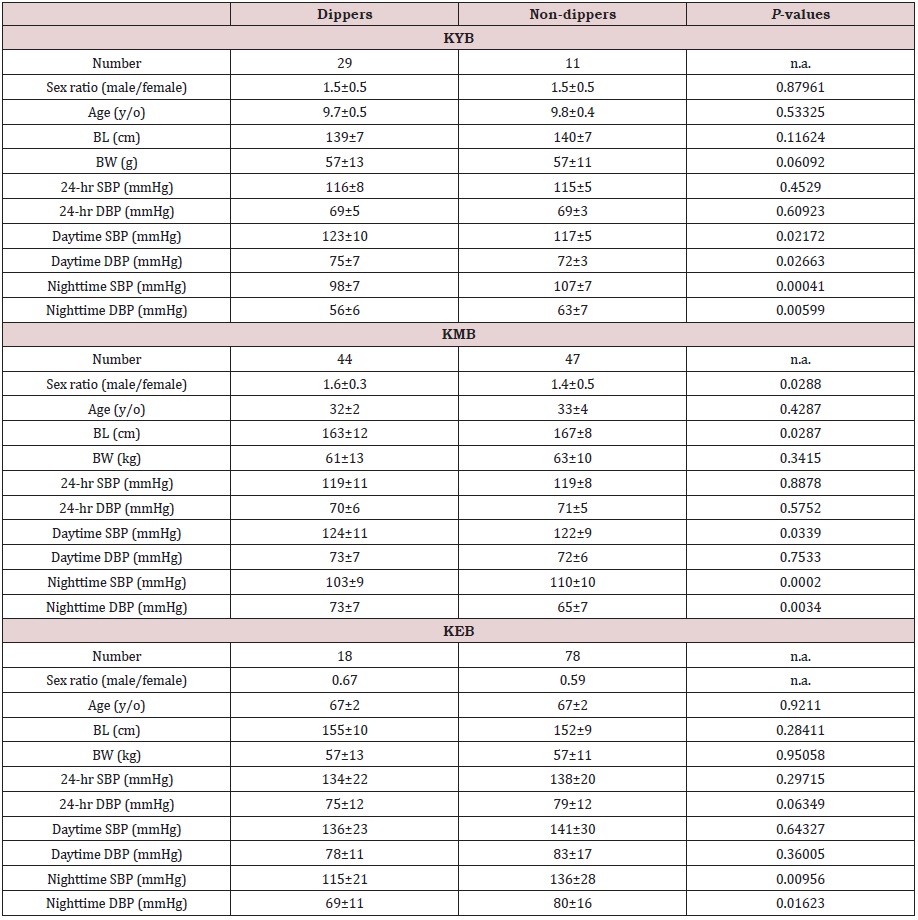Aspects of Non-Dipping Blood Pressure Variations in Juvenile, Middle-Aged, And Adult Kazakhs
ABSTRACT
Juvenile, middle-aged, and elderly Kazakhs have been found to exhibit non-dipping blood pressure variations (BPV). Such variations are seen more often in middle-aged and elderly Kazakhs than in juvenile Kazakhs. The purpose of this study was to determine whether non-dipping BPV become more common in Kazakhs with advancing age and to compare the characteristics of non-dipper and dippers in order to clarify the effects of ageing on non-dipping type BPV. We performed ambulatory blood pressure monitoring. Juvenile, middle-aged, and elderly Kazakhs were enrolled. Each age group was further divided into those with dipping and non-dipping type BPV. We analyzed systolic blood pressure (SBP) variations with the maximum entropy method (MEM). Dippers and non-dippers accounted for 81% and 19% of the juvenile Kazakhs, 48% and 52% of the middle-aged Kazakhs, and 28% and 72% of the elderly Kazakhs, respectively. MEM analysis revealed that among the middle-aged and elderly Kazakhs the SBP variations of the non-dippers exhibited a 24-hour periodicity with a weak power spectral density as well as an ultradian periodicity. These features may have contributed to the generation of a decreased circadian rhythm in SBP, and thus, ultimately led to the nondipping SBP variations observed in the middle-aged and elderly non-dipping Kazakhs. The non-dipping type BPV may have resulted from an effect of aging in Kazakhs since non-dipping BPV variations were more common in middle-aged and elderly Kazakhs than in juvenile Kazakhs.
KEYWORDS
Blood pressure variation; Non-dippers; Systolic blood pressure; Circadian variation
ABBREVIATIONS:
ABPM: Ambulatory Blood Pressure Monitoring; BPV: Blood Pressure Variations; BL: Body Length; DBP: Diastolic Blood Pressure; ECG: Electrocardiography; MEM: Maximum Entropy Method; PSD: Power Spectral Density; PR: Pulse Rate; PRC: Peoples’ Republic of China; SD: Standard Deviation; SBP: Systolic Blood Pressure
INTRODUCTION
In the northern territory of People’s Republic of China (PRC), elderly Kazakhs have been shown to exhibit a higher prevalence of hypertension and non-dipping systolic blood pressure (SBP) variations [1-3]. The present study focused on the relationship between age and non-dipping blood pressure variations (BPV) in Kazakhs. Such variations have been found to occur in both normotensive and hypertensive Kazakhs. We hypothesize that non-dipping BPV are caused by the same mechanisms in both normotensives and hypertensives. Growing evidence suggests that individuals that exhibit non-dipping BPV are more likely to be older, non-white, smokers, and diabetic and to have target organ damage than those with dipping BPV [4-6]. However, no information about how age affects non-dipping BPV in Kazakhs is available. In this report, we present BPV data collected from Kazakhs belonging to three different age groups, juvenile, middle-aged, and elderly Kazakhs, and the results of comparisons between Kazakhs that exhibited dipping type BPV and those that displayed non-dipping type BPV.
METHODS
Ethics
This study complied with the ethical principles of the Helsinki Declaration and the guidelines for good clinical practice. Each participating institution received approval for the study from their institutional review board. Written informed consent was obtained from all enrolled subjects.
Study Population
We performed cross-sectional surveillance using a previously described procedure [2,3]. Briefly clinically healthy and active juvenile Kazakhs (between 9 and 10 years old (males: 21, females: 19), middle-aged Kazakhs (between 30 and 35 years old, males: 48, females: 43), and elderly Kazakhs (between 65 and 70 years old (males: 28, females: 68) were recruited from the Balikun region of the Xinjiang Autonomic Region of PRC.
24-hr BP Monitoring
We used automatic oscillometric devices (TM2421, A&D Co., Tokyo, Japan) to record the subjects’ SBP, diastolic blood pressure (DBP), and pulse rates (PR). Meals were taken between the hours of 06:30 and 07:30, 11:00 and 12:00, and 17:30 and 18:30. Each subject was given a diary to record their daily activities, including the times at which they ate meals, slept, and micturated. All of the 24-hr measurements, as well as the subjects’ daytime and nighttime BP levels, are shown as mean values. The 24-hr measurements were averaged at 30-min intervals in order to obtain mean and standard deviation (SD) values. We defined non-dippers as subjects who exhibited a nighttime SBP reduction of <10% compared with their daytime SBP. Based on this definition, the Kazakh subjects were classified into two groups (1. Kazakhs that exhibited dipping BPV, 2. Kazakhs that displayed non-dipping BPV).
Spectral Analysis of SBP Variations
After averaging the observed data (every 30 min), the variations in the subjects’ SBP were analyzed using the MemCalc system (Suwa Trust Co. Ltd., Tokyo, Japan), as described previously [3]. The main analysis was based on the maximum entropy method (MEM) and the non-linear least squares method.
Statistical analysis
Data obtained using parametric analyses are expressed as mean±standard deviation (SD) values, and those obtained using non-parametric analyses are shown as median (Q1, Q3) values. All conventional statistical calculations were performed using the Statistical Analysis System (SAS Institute Inc., SAS Campus Drive, Cary, NC). Inter-group comparisons were carried using two-way analysis of variance (ANOVA) and the Mann–Whitney U-test. P-values of <0.05 were considered to be statistically significant.
RESULTS
Physiological Characteristics
The PR of the dippers and non-dippers did not differ significantly at any timepoint. Therefore, we did not include PR data in Table 1 to save space.
Juvenile Kazakhs (KYB): As shown in Table 1, the physiological characteristics of the dippers and non-dippers did not differ (Table 1).
No differences in the mean 24-hr SBP or DBP were detected between the dippers and non-dippers (Table 1). The SBP of the non-dippers was lower during the daytime and higher during the nighttime than that of the dippers (Table 1). The DBP of the non-dippers was lower during the daytime and higher during the nighttime than that of the dippers.
Middle-Aged Kazakhs (KMB): As shown in Table 1, except for Body length and the sex ratio, the physiological characteristics of the dippers and non-dippers did not differ (Table 1). However, the non-dippers were taller than the dippers and included more males than females. No differences in the mean 24-hr SBP or DBP were detected between the dippers and non-dippers. However, the SBP of the non-dippers was lower during the daytime and higher during the nighttime than that of the dippers.
Elderly kazakhs (KEB): The sex ratios (male/female) and mean ages of the dippers and non-dippers were similar, and no differences in body length (BL) or body weight (BW) were noted between the two groups. No differences in SBP or DBP were observed between the dippers and non-dippers during the 24-hr measurement period or during the daytime (Table 1). However, the non-dippers exhibited higher nocturnal SBP and DBP values than the dippers.
Circadian Variations in SBP
Juvenile kazakhs (KYB): The SBP variations of the dippers exhibited clear circadian variations, with their SBP rising during the daytime and falling at night (Figure 1). However, the non-dippers demonstrated less marked circadian variations in their SBP than the dippers (Figure 1).
The SBP levels of the dippers and non-dippers differed at many timepoints (dippers vs. non-dippers: 96 ± 11 vs. 116 ± 23 at 0:00; 97 ± 8 vs. 117 ± 28 at 00:30; 93 ± 10 vs. 102 ± 9 at 01:30; 93 ± 10 vs. 114 ± 23 at 02:00; 92 ± 9 vs. 103 ± 10 at 03:30; 93 ± 7 vs. 106 ± 19 at 4:00; 94 ± 11 vs. 105 ± 8 at 05:00; 96 ± 9 vs. 102 ± 8 at 06:30; 141 ± 33 vs. 125 ± 13 at 12:00; 132 ± 28 vs. 115 ± 15 at 13:30; 127 ± 23 vs.103 ± 17 at 18:00; 137 ± 31 vs. 117 ± 25 at 18:30; 124 ± 24 vs. 106 ± 17 at 22:30; all P<0.05).
Middle-aged kazakhs (KMB): The SBP variations of the dippers exhibited a clear circadian rhythm, with their SBP rising during the day and falling at night (left panel, Figure 2). However, the non-dippers demonstrated less marked circadian rhythms in their SBP variations than the dippers (Figure 2). The SBP variations of the dippers and non-dippers only differed at a few timepoints (dippers vs. non-dippers: 108±14 vs. 124±21 at 0:00; 106±24 vs. 120±21 at 00:30; 99±19 vs. 109±16 at 02:30; 97±11 vs. 107±11 at 03:00; 100±13 vs. 106± 12 at 04:30; 101±14 vs. 109±18 at 06:00; 125±23 vs. 115±17 at 08:30; 126 ±28 vs. 115±17 at 09:00; 126 ±25 vs. 118±18 at 10:30; 131±28 vs. 119±21 at 15:30; 118±22 vs. 131±24 at 23:00; 111±19 vs. 129±23:30; all P<0.05).
Elderly kazakhs (KEB): A clear circadian variation in SBP was observed in the dippers, with their SBP rising during the day and falling at night (Figure 3). As expected, the circadian variations in SBP seen in the non-dippers were not as pronounced as those observed in the dippers (Figure 3). There were differences in the circadian variations in nocturnal SBP between the dippers and non-dippers (dippers vs. non-dippers: 121±23 vs. 135±23 at 0:00; 119±27 vs. 136±23 at 030; 116±26 vs. 137±25 at 01:00; 115±28 vs. 134±23 at 01:30;. 115±21 vs. 136±23 at 02:00; 115±24 vs. 137±25 at 02:30; 110±20 vs. 136±25 at 03:00; 112±21 vs. 140±24 at 03:30; 114±22 vs. 141±25 at 04:00; 115±19 vs. 140±19 at 04:30; 114±18 vs. 140±23 at 05:00; 117±16 vs. 142±23 at 05:30; 120±17 vs. 140±24 at 06:00; 123±21 vs. 141±25 at 06:30; 132±20 vs. 145±25 at 07:30; all P<0.05).
Spectral analysis of SBP variations
Juvenile kazakhs (KYB): We analyzed the variations in the mean SBP values of the juvenile Kazakhs using MEM, which revealed that the SBP variations of the dippers and non-dippers displayed a 24-hr periodicity (at approximately 0.04 1/hr) and ultradian variations. The 24-hr periodicity of the dippers’ SBP values demonstrated a greater power spectral density (PSD) than that of the non-dippers (Figure 4). The SBP variations of the nondippers exhibited a 24-hr periodicity (at 0.04 1/hr) with a very weak PSD (Figure 4).
Middle-aged Kazakhs (KMB): We analyzed the variations in the mean SBP values of the middle-aged Kazakhs using MEM analysis, which revealed that the SBP variations of the dippers displayed a 24-hr periodicity (at approximately 0.04 1/hr) and a greater PSD than the SBP variations of the non-dippers (upper panel, Figure 5). On the other hand, the SBP variations of the nondippers exhibited a 24-hr periodicity with a very weak PSD as well as an ultradian periodicity (lower panel, Figure 5).
Elderly Kazakhs (KEB): In the dippers, the highest PSD peak was seen at approximately 0.004 1/hr, which was associated with a 26.8-hr periodicity. Additional PSD peaks were also observed at 0.2 1/hr (with a 6.6-hr periodicity) and 0.1 1/hr (with a 13-hr periodicity) (upper panel, Figure 6). In the non-dippers, a small PSD peak was observed at approximately 0.004 1/hr, which was associated with a 24-hr periodicity. Relatively high PSD peaks were also seen at 0.2 1/hr (with a 6-hr periodicity) and 0.14 1/hr (with a 7-hr periodicity) (lower panel, Figure 6).
Effects of Aging on Non-Dipping Variations in SBP
As shown in Figure 7, the dippers and non-dippers accounted for 72% and 28% of the juvenile Kazakhs, respectively (Figure 7). In addition, the dippers and non-dippers accounted for 48% and 52% of the middle-aged Kazakhs and 19% and 81% of the elderly Kazakhs, respectively.
DISCUSSION
Circadian Variations in SBP
Previously we reported that many elderly Kazaks were hypertensive and non-dippers [2,3,7]. The reduced SBP amplitude observed in our non-dipping subjects agrees with previously reported results [8].
We only analyzed SBP, since DBP variations are generally smaller than SBP variations. Our previous results suggested that 52% of middle-aged Kazakhs are non-dippers, but also that such individuals exhibit similar physiological characteristics to dippers. It was previously demonstrated that the likelihood of becoming a non-dipper increases with age [8,9]. In the present study, the living conditions of the dippers and non-dippers were similar, and the timing of physical activities, such as eating, rising, and sleeping, was also standardized.
To confirm when physical activities occurred, we examined the diaries of all of the subjects. It has also been reported that nocturnal physical activity, waking, micturition, and insomnia are all suggestive of increased nocturnal sympathetic activity and may lead to the development of a non-dipping status [10]. In field surveillance studies, similar to the current study, it is difficult to assess sleep quality using polysomnography alone. Our previous findings suggested that the development of a non-dipping BPV pattern may be caused, at least in part, by the generation of weak circadian rhythms due to insufficient cardiac autonomic function and decreased physical activity during the daytime in juvenile and middle-aged Kazakhs [11,12].
This phenomenon may be age-related, as we reported in our previous studies [3,4,9,11]. Based on the findings of the present study, the number of non-dippers seems to increase with age. Our results suggest that 52% of middle-aged Kazakhs are nondippers, but also demonstrated that such individuals have similar physiological characteristics to dippers. The SBP variations of the non-dippers exhibited a less marked circadian rhythm right panels, (Figure 1-3) and many ultradian periodicities lower panels (Figures 5,6). Our results suggest that 81% of elderly Kazakhs are nondippers (Figure 7). The SBP variations of the non-dippers exhibited weaker circadian rhythms and many ultradian periodicities.
A previous study suggested that aerobic exercise improved gait velocity and step length in non-dipping elderly subjects [13]. This may improve the survival of non-dippers. Therefore, it would be interesting to investigate the differences between the survival rates of dipping and non-dipping Kazakhs in future studies.
Our findings suggest that the development of a non-dipping BPV pattern could be caused, at least in part, by the generation of a weak circadian rhythm due to insufficient cardiac sympathetic function during the day, increased ultradian rhythmicity, and decreased daytime physical activity [11,12].
LIMITATIONS
The small inter-group variations seen in the mean values of the majority of the examined parameters suggest that our failure to detect significant differences between most of the variables was not due to a lack of statistical power. However, the study population was not large enough to allow it to be divided into normotensives and hypertensives. We speculate that the mechanism responsible for non-dipping is the same in normotensives and hypertensives since blood pressure gradually increases with age. Another limitation of this particular type of study is the necessity to assign subjects to a group based on their characteristics (dipper pattern) rather than at random. While the self-selecting aspect of this cross-sectional study was unavoidable, it proved to be the study’s main limitation. The final limitation of the current study is that the period of BP monitoring was only 24 hr.
This may have been too brief to allow a thorough and reliable evaluation of BPV or the elimination of extraneous influences, such as the novelty of the study setting. However, conducting a large-scale ABPM field study over a period longer than 24 hr in such a remote location is simply not practical. In any case, we consider that none of the abovementioned limitations significantly influenced any of the conclusions reached in the present study.
PERSPECTIVES
We hypothesize that in the Kazakh population, dippers will have longer lifespans than non-dippers. In addition, further chronobiological studies of this minority population in the PRC may be a valuable way of identifying lifestyle factors that are important for improving the overall survival rate of non-dippers.
CONCLUSION
Non-dipping juvenile, middle-aged and elderly Kazakhs demonstrated SBP variations that exhibited a 24-hr periodicity with a decreased PSD and ultradian periodicity. In addition, the numbers of non-dippers increased with age.
REFERENCES
- Wu X, Duan X, Gu D, Hao J, Tao S, et al. (1995) Prevalence of hypertension and its trends in Chinese populations. Int J Cardiol 52(1): 39-44.
- Kawamura H, Jumabay M, Mitsubayashi H, Izumi Y, Soma M, et al. (2000) 24-hr blood pressure in Uygur, Kazakhs and Han elderly subjects in China. Hypertens Res 23(2): 177-185.
- Kawamura H, Mitsubayashi H, Izumi Y (2009) Analysis of heart rate variability amongst non-dipper Kazakh, Xinjiang, China. Jpn J Clin Physiol 39: 155-162.
- Hermida PC, Ayaia DF, Mojon A, Fernandez JR (2013) Blunted sleeptime relative blood pressure decline increases cardiovascular risk independent of blood pressure level-the ‘‘normotensive non-dipper’’ paradox. Chronobiol Int 30(1): 87-98.
- Verdecchia P, Schillaci G, Guerrieri M, Benemio G, Boldrini F, et al. (1990) Circadian blood pressure changes and left ventricular hypertrophy in essential hypertension. Circulation 81(2): 528-536.
- Brotman DJ, Davidson MB, Boumitri M, Vidt DG (2008) Impaired diurnal blood pressure variation and all-cause mortality. Am J Hypertens 21(1):92-97.
- Mu YM, Ozawa Y, Wang SZ (2000) Ultrasonographic study of carotid artery structural changes with natural longevity. Circ J 64: 243-248.
- Staessen JA, Bienaszewski L, O’Brien E, Gosse P, Hayashi H, et al. (1997) Nocturnal blood pressure fall on ambulatory blood pressure monitoring in a large international database. Hypertension 29: 30-39.
- Peres-Lloret S, Aguirre AG, Cardinali DP, Toblli JE (2004) Disruption of ultradian and circadian rhythms of blood pressure in nondipper hypertensive patients. Hypertension 44(3): 311-315.
- Ragot S, Harpin D, Siche JP, Ingrand P, Ingrand P, Mallion JM (1999) Autonomic nervous system activity in dipper and nondipper essential hypertensive patients. What about sex differences? J Hypertens 17: 1805-1811.
- Kawamura H, Ozawa Y, Izumi Y, Kasamaki Y, Nakayama T, et al (2016) Non-dipping blood pressure variations in adult Kazakhs are derived from decreased daytime physical activity and increased nighttime sympathetic activity and decreased parasympathetic activity. Clin Exp Hypertens 38(2): 194-202
- Kawamura H, Ozawa Y, Izumi Y, Kasamaki Y, Nakayama T, et al. (2020) Non-dipping blood pressure variations in juvenile Kazakhs are derived from increased sympathetic activity and decreased parasympathetic activity. Particularly decreased daytime physical activity Open Acc J Bio Sci 3(1): 631-639.
- Narlon C, Silva BS, Gregory MA, Petrella RJ (2018) The impact of blood pressure dipping status on cognition, mobility, and cardiovascular health in older adults following an exercise program. Gerontology & Geriatric Medicine 4: 1-11.
Article Type
Research Article
Publication history
Received Date: November 26, 2021
Published: December 29, 2021
Address for correspondence
Hiroshi Kawamura, Blood Pressure Center, Myojyougakuen (MJG) Cardiovascular Institute, Japan
Copyright
©2021 Open Access Journal of Biomedical Science, All rights reserved. No part of this content may be reproduced or transmitted in any form or by any means as per the standard guidelines of fair use. Open Access Journal of Biomedical Science is licensed under a Creative Commons Attribution 4.0 International License
How to cite this article
Hiroshi K. Aspects of Non-Dipping Blood Pressure Variations in Juvenile, Middle-Aged, And Adult Kazakhs. 2021- 3(6) OAJBS.ID.000367.
Figure 1: Circadian variations in SBP in KYB. Juvenile Kazaks exhibited clear circadian variations in their SBP, which rose during the daytime and fell at night (left and right panels). However, these circadian variations were less clear in the non-dipping juvenile Kazakhs, as shown in the right panel.
Figure 2: Circadian variations in SBP in middle-aged Kazakhs. Middle-aged Kazaks exhibited clear circadian variations in their SBP, which rose during the daytime and fell at night (left and right panels). However, these circadian variations were less clear in the non-dipping middle-aged Kazakhs, as shown in the right panel.
Figure 3: Circadian variations in SBP in elderly Kazakhs. Elderly Kazaks exhibited clear circadian variations in their SBP, which rose during the daytime and fell at night (left panel). However, these circadian variations were less clear in the non-dipping elderly Kazakhs, as shown in the right panel.
Figure 4: Spectral density of the SBP variations seen in juvenile Kazakhs. The SBP variations of the dipping juvenile Kazakhs displayed a 24-hr periodicity (close to 0.04 1/hr) and ultradian variations (upper panel) and a greater PSD than those of the non-dippers (lower panel). In contrast to those of the dippers, the SBP variations of the nondippers exhibited a 24-hr periodicity with a very weak PSD and ultradian variations (lower panel).
Figure 5: Spectral density of the SBP variations seen in middle-aged Kazakhs. The SBP variations of the dipping middle-aged Kazakhs displayed a 24-hr periodicity (close to 0.04 1/hr) and ultradian variations (upper panel) and a greater PSD than those of the non-dippers (lower panel). In contrast to those of the dippers, the SBP variations of the non-dippers exhibited a 24-hr periodicity with a very weak PSD and ultradian variations (lower panel).
Figure 6: Spectral density of the variations in SBP seen in elderly Kazakhs. The SBP variations of the dipping elderly Kazakhs displayed a 24-hr periodicity (close to 0.04 1/hr) and ultradian variations (upper panel) and a greater PSD than those of the non-dippers (lower panel). In contrast to those of the dippers, the SBP variations of the nondippers exhibited a 24-hr periodicity with a very weak PSD and many ultradian variations with greater PSD (lower panel).
Figure 7: Percentages of dippers and non-dippers among juvenile, middle-aged, and elderly Kazakhs The open bars show the percentage of dippers, and the striped bars show the percentage of non-dippers.
Table 1: Physiological characteristics of juvenile, middle-aged, and elderly Kazakhs.


